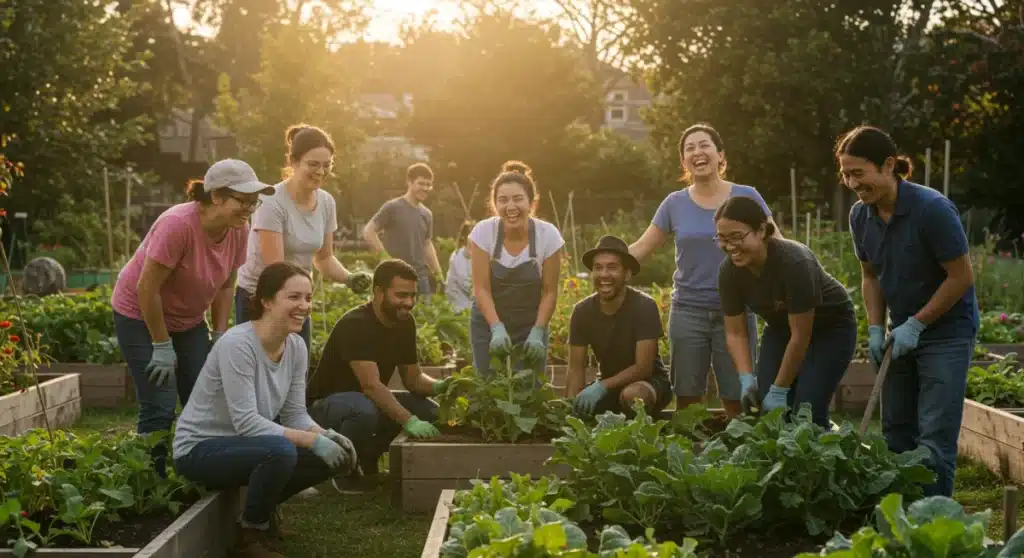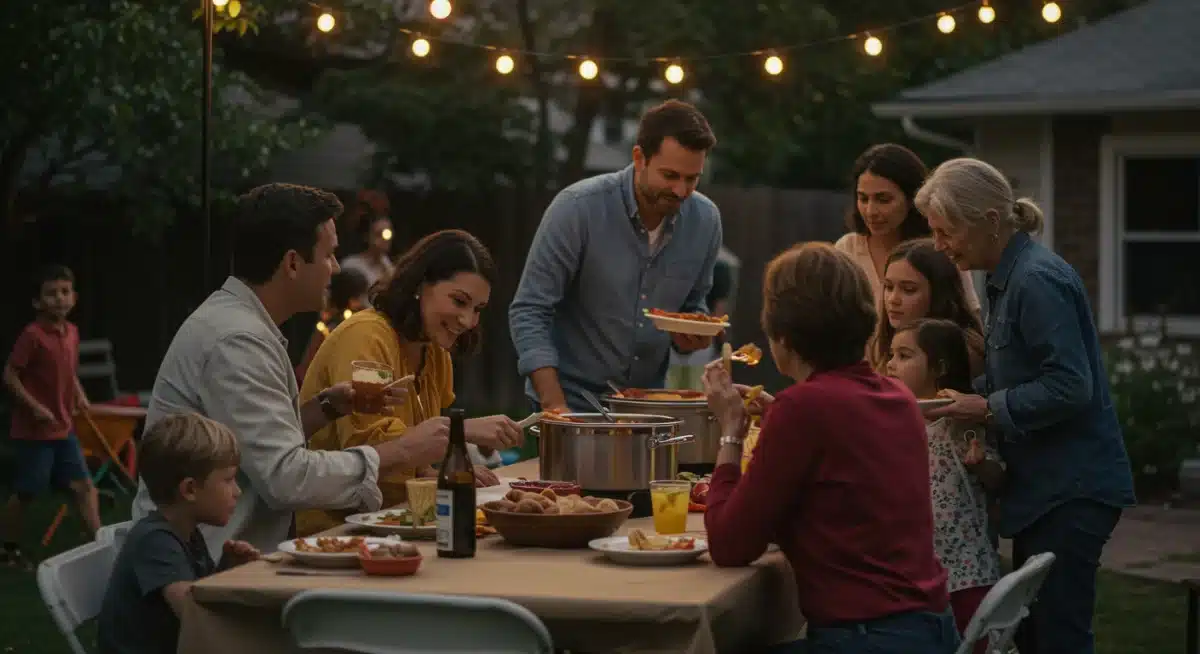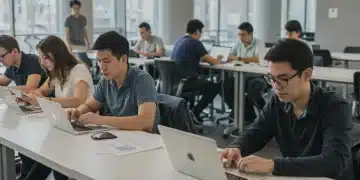Reimagining Community: 4 Ways Americans Are Building Stronger Local Connections

Americans are actively reimagining community connections, fostering stronger local bonds through diverse initiatives like enhanced civic engagement, mutual aid networks, and innovative digital platforms, adapting to current societal shifts.
In a rapidly evolving social landscape, the imperative to strengthen local bonds has never been more evident. Many Americans are currently reimagining community connections, actively seeking innovative ways to foster solidarity and mutual support within their neighborhoods.
The Rise of Hyperlocal Initiatives
Across the United States, citizens are increasingly turning to hyperlocal initiatives to build more resilient and interconnected communities. These efforts often manifest in grassroots projects that address specific local needs, ranging from neighborhood watch programs to community-led environmental cleanups. This movement underscores a desire for tangible, immediate impact on their surroundings.
The emphasis on the local scale allows for more direct participation and a stronger sense of ownership among residents. Recent reports indicate a surge in volunteerism for these types of projects, especially in urban and suburban areas where anonymity can sometimes prevail. This renewed focus on local action is a direct response to a perceived need for greater cohesion and collective problem-solving.
Community Gardens and Shared Spaces
One prominent example of hyperlocal initiatives is the proliferation of community gardens and shared public spaces. These areas serve as vital hubs for interaction, fostering not only environmental stewardship but also social bonds.
- Shared Responsibility: Residents collaboratively plan, plant, and maintain gardens, sharing both the work and the harvest.
- Intergenerational Exchange: Gardens often bring together people of all ages, facilitating knowledge transfer and creating mentorship opportunities.
- Food Security: In some communities, these gardens contribute to local food security, providing fresh produce to those in need.
Neighborhood Watch Programs
Neighborhood watch programs, while not new, are experiencing a resurgence with modern adaptations. Digital communication tools now allow for more efficient information sharing and rapid response among residents, enhancing safety and fostering a collective sense of responsibility for local well-being.
Leveraging Digital Platforms for Connection
While often criticized for isolating individuals, digital platforms are paradoxically becoming powerful tools for reimagining community connections. From dedicated social media groups to specialized local apps, technology is bridging gaps and enabling new forms of interaction that were previously difficult to coordinate.
These platforms offer a convenient way for neighbors to communicate, organize events, share resources, and even offer assistance. The immediacy and widespread reach of digital tools allow for rapid dissemination of information and mobilization of community members, particularly during local crises or for urgent needs. This blend of digital convenience with real-world engagement is reshaping how communities interact.
Nextdoor and Local Facebook Groups
Platforms like Nextdoor and localized Facebook groups have become indispensable for many communities. They serve as virtual town squares where residents can discuss local issues, recommend services, and organize local events.
- Instant Communication: Alerts about local crime, lost pets, or urgent needs can be shared in real-time.
- Event Coordination: Neighbors use these groups to plan block parties, garage sales, and community clean-ups.
- Resource Sharing: Members often post requests for tools, skills, or advice, fostering a culture of mutual support.
Specialized Community Apps
Beyond mainstream social media, a growing number of specialized apps are emerging, tailored to specific community needs such as time banking, skill-sharing, or local exchange networks. These platforms facilitate a more structured approach to reciprocal aid and resource distribution.
The Resurgence of Mutual Aid Networks
The concept of mutual aid, where communities collectively support each other through direct action rather than relying solely on traditional institutions, has seen a significant resurgence. This movement is a testament to the proactive spirit of Americans in reimagining community connections during challenging times, particularly in response to economic shifts and social disruptions.
These networks are often volunteer-driven and focus on addressing immediate needs such as food insecurity, housing assistance, or healthcare access. They operate on principles of solidarity, reciprocity, and autonomy, empowering individuals to contribute to and benefit from collective efforts. The flexibility and responsiveness of mutual aid groups allow them to adapt quickly to evolving community demands.

Food Banks and Community Fridges
Community-run food banks and public refrigerators are prime examples of mutual aid in action. These initiatives provide accessible food resources to those facing hardship, often stocked and maintained by local volunteers and donations.
- Direct Provision: Food is made available directly to those who need it, with minimal bureaucracy.
- Waste Reduction: Surplus food from homes and businesses can be repurposed, reducing waste.
- Volunteer Engagement: These projects rely heavily on volunteers for collection, distribution, and maintenance, strengthening local bonds.
Skill-Sharing and Time Banks
Another facet of mutual aid involves skill-sharing and time banks, where individuals exchange services based on time rather than money. This fosters a sense of interdependence and values diverse talents within a community.
Renewed Emphasis on Civic Engagement
A notable trend in reimagining community connections involves a renewed and invigorated emphasis on civic engagement. Americans are increasingly participating in local governance, advocacy groups, and public forums, recognizing that active participation is crucial for shaping their communities and ensuring their voices are heard. This engagement goes beyond traditional voting, encompassing a broader spectrum of activities aimed at direct influence and collective decision-making.
This heightened civic participation is often driven by a desire for greater transparency, accountability, and responsiveness from local authorities. Citizens are organizing to advocate for specific policies, challenge existing norms, and collectively work towards creating more equitable and sustainable environments. This bottom-up approach to civic action is proving to be a powerful force for change and community building.
Local Town Halls and Public Meetings
Attendance and participation in local town halls and public meetings have seen an uptick. Residents are more actively engaging with their elected officials, voicing concerns, and proposing solutions on issues ranging from zoning laws to public safety.
- Direct Dialogue: Provides a platform for citizens to directly question and influence local policy-makers.
- Community Consensus: Helps in building a collective understanding and potential consensus on local issues.
- Accountability: Holds local government accountable to the needs and desires of the populace.
Advocacy for Local Causes
From environmental protection to affordable housing, local advocacy groups are gaining momentum. These groups mobilize community members to lobby for specific causes, often leading to significant policy changes and improved local conditions.
The Role of Local Businesses and Organizations
Local businesses and community organizations are playing an increasingly pivotal role in reimagining community connections. They serve as anchors, providing not only goods and services but also acting as informal gathering places and sponsors of local events. Their deep roots within the community make them natural facilitators of social interaction and collective identity.
Many local businesses are actively partnering with non-profits and community groups to support initiatives that benefit residents. This collaborative approach strengthens the local economy while simultaneously fostering a sense of shared purpose. The symbiotic relationship between local commerce and community well-being is becoming more pronounced, highlighting the multifaceted nature of strong local bonds.
Supporting Local Entrepreneurs
The movement to ‘buy local’ extends beyond economic benefits; it’s a conscious choice to invest in the fabric of the community. Supporting local entrepreneurs helps create jobs, retains capital within the area, and often leads to more personalized services and products.
- Economic Resilience: Strong local businesses contribute to a more stable and diverse local economy.
- Unique Character: Local shops and restaurants often give a community its distinct character and charm.
- Community Events: Many local businesses sponsor or host community events, drawing people together.
Community Centers and Non-Profits
Community centers and local non-profit organizations remain crucial hubs for social activity, offering programs and services that cater to diverse demographics. These entities are often at the forefront of addressing social needs and fostering inclusivity.
Building Resilience Through Shared Experiences
At the core of reimagining community connections is the fundamental act of building resilience through shared experiences. When individuals come together to face challenges, celebrate successes, or simply coexist, they forge bonds that are stronger than mere acquaintance. These shared moments, whether planned or spontaneous, contribute significantly to the collective well-being and adaptive capacity of a community.
From neighborhood clean-up days to local festivals, these shared experiences create a collective memory and a sense of belonging. They break down social barriers, foster empathy, and build trust among residents. In an era marked by rapid change and uncertainty, the ability of a community to lean on its members through shared understanding and mutual support is invaluable for long-term sustainability and happiness.
Local Festivals and Events
Local festivals, farmers’ markets, and cultural events are powerful catalysts for bringing people together. These gatherings celebrate local identity, showcase local talent, and provide informal opportunities for interaction and connection.
- Cultural Exchange: Festivals often highlight the diverse cultures within a community, promoting understanding and appreciation.
- Economic Boost: They provide opportunities for local artisans and food vendors, stimulating the local economy.
- Social Cohesion: These events are a natural setting for casual conversations and the formation of new friendships.
Volunteer Opportunities
Volunteering for local causes, beyond structured mutual aid, offers another avenue for shared experiences. Working alongside neighbors for a common good strengthens social ties and instills a sense of collective achievement.
| Key Aspect | Brief Description |
|---|---|
| Hyperlocal Initiatives | Grassroots projects like community gardens and neighborhood watches fostering direct local engagement. |
| Digital Platform Use | Leveraging apps and social media for communication, event coordination, and resource sharing among neighbors. |
| Mutual Aid Networks | Volunteer-driven groups providing direct support for food, housing, and other community needs. |
| Civic Engagement | Increased participation in local governance, town halls, and advocacy for community-specific causes. |
Frequently Asked Questions About Community Building
Hyperlocal initiatives are grassroots projects focused on specific local needs, such as community gardens or neighborhood watch programs. They foster direct participation and a strong sense of ownership among residents, addressing immediate community challenges effectively.
Digital platforms like Nextdoor and local Facebook groups facilitate communication, event organization, and resource sharing among neighbors. They provide instant alerts and coordination tools, bridging geographical gaps and enabling rapid community mobilization.
Mutual aid networks are volunteer-driven systems where community members collectively support each other, often addressing needs like food insecurity or housing. They operate on principles of solidarity and reciprocity, providing flexible and responsive assistance.
Renewed civic engagement allows residents to actively participate in local governance, advocate for policies, and shape their communities. It ensures transparency, accountability, and responsiveness from local authorities, leading to more equitable environments.
Local businesses serve as community anchors, providing goods, services, and informal gathering spaces. They often partner with non-profits and sponsor local events, fostering economic stability and a shared sense of purpose within the community.
Looking Ahead
The ongoing efforts in reimagining community connections signal a significant shift in how Americans are choosing to interact and support one another. As societal challenges continue to evolve, these innovative approaches to building stronger local bonds will likely become even more critical. Watch for increasing integration of digital tools with physical spaces, alongside a continued emphasis on self-sufficiency and collective action within neighborhoods. The momentum suggests a future where local communities are more resilient, interconnected, and capable of addressing their own needs from within, adapting dynamically to upcoming changes.





